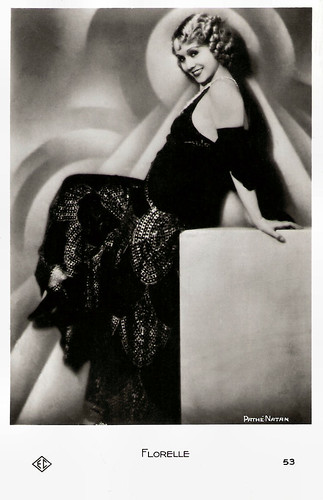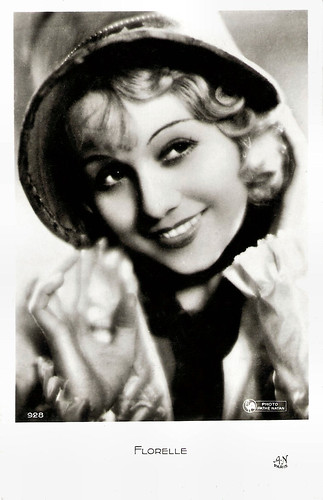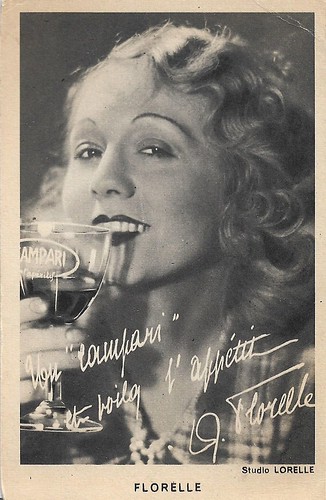French music hall star Florelle (1898-1974) was one of the queens of Paris. The petite blonde appeared in 54 films between 1912 and 1956 and toured around the world. Her most beautiful role was as Fantine in a classic version of Les Misérables (1934).

French postcard by EC (Editions Chantal), no. 53. Photo: Pathé-Natan.

French postcard by A.N., Paris, no. 928. Photo: Pathé-Natan. Florelle as Fantine in Les Miserables (Raymond Bernard, 1934).

French card by Cinémagazine-Editions, no. 1079. Photo: Paramount.
Florelle was born Odette Elisa Joséphine Marguerite Rousseau in Les Sables-d'Olonne, France in 1898. Her father was a modest commercial employee. In 1905 her parents moved to Paris and her mother Diadéma became the cashier of La Cigale, a café-concert in Montmartre. At 14, Florelle appeared on stage in a sketch with Raimu.
That same year she made her film debut credited as Mlle Rousseau in the Pathé production Le masque d'horreur/The Mask of Horror (1912). This short silent French horror film was directed by legendary director Abel Gance and co-starred famous French actors such as Edouard de Max and Charles de Rochefort. A mad sculptor, searching for the perfect realisation of ‘the mask of horror’, places himself in front of a mirror after smearing blood over himself with the glass of an oil lamp. He then swallows a virulent poison to observe the effects of pain.
Florelle then played in another silent short for the production company Le Film d’art, La petite Fifi/The Crime on the Coast (Henri Pouctal, 1913) starring Marcel Vibert. Florelle showed a gift for singing and started to perform, first at La Cigale and other Montmartre venues, later in Austria, Romania, and Turkey. From 1918 on, she was back in the Montmartre music halls and became one of the queens of Paris.
From 1923 on, she continued her film career with such silent films as the mystery L'affaire de la rue de Lourcine/e Case of the Rue de Lourcine (Henri Diamant-Berger, 1923) with Maurice Chevalier. She was now credited as Odette Florelle.
For director Henri Diamant-Berger, she also appeared in L'accordeur/The Tuner (Henri Diamant-Berger, 1923), starring Louis Pré Fils and Albert Préjean, Jim Bougne, boxeur/ Boxer Jim Bougne (Henri Diamant-Berger, 1923), and in Gonzague (Henri Diamant-Berger, 1923) both again with Maurice Chevalier. But then, she went on tour again and performed in Cuba, South America, Greece and Turkey.

French postcard in the Collection Astra, Les Sables-d'Olonne, no. 59. Posted by mail in 1937. Photo: Combier Mâcon.

French postcard by Cinémagazine-Edition, no. 968. Photo: Studio G.L. Manuel Frères.

Belgian collector card, which promotes the screening of the film at Majestic, Gand. Photo: Pathé-Natan. Florelle as Fantine in Les Misérables (Raymond Bernard, 1934). Caption: Une tempête sous un crane (A storm under a skull).
After the introduction of sound film, Florelle played in several alternate language versions of foreign films. In 1930, she appeared at the side of Jean-Max and Colette Darfeuil in the French drama Le procureur Hallers/The Prosecutor Hallers (Robert Wiene, 1930). It was the French-language version of the German Tobis-production Der Andere/The Other, based on a play by Paul Lindau. The two films were made at the same studio in Berlin, with director Robert Wiene beginning work on the French version immediately after finishing the German film.
In Berlin, Georg Wilhelm Pabst invited her for a screen test for his film L'opéra de quat' sous/The Threepenny Opera (1930). James Travers at French Films: "In 1928, Bertolt Brecht et Kurt Weill worked on one of their most successful collaborations, 'Die Dreigroschenoper', a stage play based on John Gay’s 1728 satire, 'The Beggar’s Opera'. The success of the play soon led to a film adaptation by G.W. Pabst, then one of Germany’s most prominent directors.
Three versions of the film were planned – one in English, one in German, and one in French. The English version was abandoned early and the German and French versions were made in parallel, with two separate casts. The German version, Die Dreigroschenoper, is the most widely available. L’Opéra de quat’ sous was the name given to the French version.” Florelle got the role of Polly Peachum and her interpretations of the Kurt Weil songs were a huge success.
The operetta Nuits de Venise/Venetian Nights (Pierre Billon, Robert Wiene, 1931) was an alternative-language version of the German comedy Der Liebesexpreß/The Love Express (Robert Wiene, 1931), made at the Emelka Studios in Munich. Florelle played in the classic fantasy L'Atlantide (Georg Wilhelm Pabst, 1932), an alternate language version of Die Herrin von Atlantis/Queen of Atlantis (Georg Wilhelm Pabst, 1932). In both versions, Brigitte Helm starred as the Queen of Atlantis. Florelle performed an unforgettable Can-can in the film.
She then played the lead role in the British French-language comedy La dame de chez Maxim's/The Girl from Maxim's (Alexander Korda, 1933). It was the alternate language version of The Girl from Maxim's (Alexander Korda, 1933) made by London Film Productions. Both films were based on the 1899 farce 'La Dame de chez Maxim' by Georges Feydeau. Her lively, fresh and carefree performances made her a popular film star, while she also was the ’vedette’ at the Folies Bergère, at the Moulin Rouge, and at the Casino de Paris...

French postcard by Editions Cinémagazine, no. 2009. Photo: Paramount.

French postcard by Editions Chantal (EC), Paris, no. 33. Photo: Utudjian.
One of Florelle’s most important films was Les Misérables (1934), an adaptation of Victor Hugo's novel. Raymond Bernard wrote and directed it and Harry Baur starred as Jean Valjean and Charles Vanel as Javert. Florelle played Fantine, a woman forced into prostitution to help pay two cruel innkeepers. Wikipedia: "The film lasts four and a half hours and is considered by critics to be the greatest adaptation of the novel, due to its in-depth development of the themes and characters in comparison with most shorter adaptations." It was released as three films that premiered over a period of three weeks.

French postcard by EC (Editions Chantal), no. 53. Photo: Pathé-Natan.

French postcard by A.N., Paris, no. 928. Photo: Pathé-Natan. Florelle as Fantine in Les Miserables (Raymond Bernard, 1934).

French card by Cinémagazine-Editions, no. 1079. Photo: Paramount.
The Mask of Horror
Florelle was born Odette Elisa Joséphine Marguerite Rousseau in Les Sables-d'Olonne, France in 1898. Her father was a modest commercial employee. In 1905 her parents moved to Paris and her mother Diadéma became the cashier of La Cigale, a café-concert in Montmartre. At 14, Florelle appeared on stage in a sketch with Raimu.
That same year she made her film debut credited as Mlle Rousseau in the Pathé production Le masque d'horreur/The Mask of Horror (1912). This short silent French horror film was directed by legendary director Abel Gance and co-starred famous French actors such as Edouard de Max and Charles de Rochefort. A mad sculptor, searching for the perfect realisation of ‘the mask of horror’, places himself in front of a mirror after smearing blood over himself with the glass of an oil lamp. He then swallows a virulent poison to observe the effects of pain.
Florelle then played in another silent short for the production company Le Film d’art, La petite Fifi/The Crime on the Coast (Henri Pouctal, 1913) starring Marcel Vibert. Florelle showed a gift for singing and started to perform, first at La Cigale and other Montmartre venues, later in Austria, Romania, and Turkey. From 1918 on, she was back in the Montmartre music halls and became one of the queens of Paris.
From 1923 on, she continued her film career with such silent films as the mystery L'affaire de la rue de Lourcine/e Case of the Rue de Lourcine (Henri Diamant-Berger, 1923) with Maurice Chevalier. She was now credited as Odette Florelle.
For director Henri Diamant-Berger, she also appeared in L'accordeur/The Tuner (Henri Diamant-Berger, 1923), starring Louis Pré Fils and Albert Préjean, Jim Bougne, boxeur/ Boxer Jim Bougne (Henri Diamant-Berger, 1923), and in Gonzague (Henri Diamant-Berger, 1923) both again with Maurice Chevalier. But then, she went on tour again and performed in Cuba, South America, Greece and Turkey.

French postcard in the Collection Astra, Les Sables-d'Olonne, no. 59. Posted by mail in 1937. Photo: Combier Mâcon.

French postcard by Cinémagazine-Edition, no. 968. Photo: Studio G.L. Manuel Frères.

Belgian collector card, which promotes the screening of the film at Majestic, Gand. Photo: Pathé-Natan. Florelle as Fantine in Les Misérables (Raymond Bernard, 1934). Caption: Une tempête sous un crane (A storm under a skull).
The Threepenny Opera
After the introduction of sound film, Florelle played in several alternate language versions of foreign films. In 1930, she appeared at the side of Jean-Max and Colette Darfeuil in the French drama Le procureur Hallers/The Prosecutor Hallers (Robert Wiene, 1930). It was the French-language version of the German Tobis-production Der Andere/The Other, based on a play by Paul Lindau. The two films were made at the same studio in Berlin, with director Robert Wiene beginning work on the French version immediately after finishing the German film.
In Berlin, Georg Wilhelm Pabst invited her for a screen test for his film L'opéra de quat' sous/The Threepenny Opera (1930). James Travers at French Films: "In 1928, Bertolt Brecht et Kurt Weill worked on one of their most successful collaborations, 'Die Dreigroschenoper', a stage play based on John Gay’s 1728 satire, 'The Beggar’s Opera'. The success of the play soon led to a film adaptation by G.W. Pabst, then one of Germany’s most prominent directors.
Three versions of the film were planned – one in English, one in German, and one in French. The English version was abandoned early and the German and French versions were made in parallel, with two separate casts. The German version, Die Dreigroschenoper, is the most widely available. L’Opéra de quat’ sous was the name given to the French version.” Florelle got the role of Polly Peachum and her interpretations of the Kurt Weil songs were a huge success.
The operetta Nuits de Venise/Venetian Nights (Pierre Billon, Robert Wiene, 1931) was an alternative-language version of the German comedy Der Liebesexpreß/The Love Express (Robert Wiene, 1931), made at the Emelka Studios in Munich. Florelle played in the classic fantasy L'Atlantide (Georg Wilhelm Pabst, 1932), an alternate language version of Die Herrin von Atlantis/Queen of Atlantis (Georg Wilhelm Pabst, 1932). In both versions, Brigitte Helm starred as the Queen of Atlantis. Florelle performed an unforgettable Can-can in the film.
She then played the lead role in the British French-language comedy La dame de chez Maxim's/The Girl from Maxim's (Alexander Korda, 1933). It was the alternate language version of The Girl from Maxim's (Alexander Korda, 1933) made by London Film Productions. Both films were based on the 1899 farce 'La Dame de chez Maxim' by Georges Feydeau. Her lively, fresh and carefree performances made her a popular film star, while she also was the ’vedette’ at the Folies Bergère, at the Moulin Rouge, and at the Casino de Paris...

French postcard by Editions Cinémagazine, no. 2009. Photo: Paramount.

French postcard by Editions Chantal (EC), Paris, no. 33. Photo: Utudjian.
Les Misérables
One of Florelle’s most important films was Les Misérables (1934), an adaptation of Victor Hugo's novel. Raymond Bernard wrote and directed it and Harry Baur starred as Jean Valjean and Charles Vanel as Javert. Florelle played Fantine, a woman forced into prostitution to help pay two cruel innkeepers. Wikipedia: "The film lasts four and a half hours and is considered by critics to be the greatest adaptation of the novel, due to its in-depth development of the themes and characters in comparison with most shorter adaptations." It was released as three films that premiered over a period of three weeks.
Florelle had a small role in Liliom (Fritz Lang, 1936) starring Charles Boyer. It is the only film Fritz Lang made in France, after he fled Nazi Germany and before moving to the States, and he brings all his skill and heart and humour to the wonderful Ferenc Molnar story.
Another classic is Le Crime de Monsieur Lange/The Crime of Monsieur Lange (Jean Renoir, 1936) about a publishing cooperative. Wikipedia: "Imbued with the spirit of the left-wing political movement, Popular Front, which would have a major political victory that year, the film chronicles the story of M. Lange (René Lefèvre), a mild-mannered clerk at a publishing company who dreams of writing Western stories. He gets his chance when Batala (Jules Berry), the salacious head of the company, fakes his own death and the abandoned workers decide to form a cooperative. They have great success with Lange's stories about the cowboy, Arizona Jim — whose stories parallel the real-life experiences of the cooperative. At the same time, Lange and his neighbor, Valentine (Florelle), fall in love.”
After 1940, the cinema seemed to have forgotten her, and she moved to North Africa. Later, Florelle hosted a bar in Montmartre and sang in cabarets and music halls. Incidentally, she appeared in small film parts. An example is the anthology film Trois femmes/Three Women (André Michel, 1952), which was entered into the 1952 Cannes Film Festival.
Later she had a part in Gervaise (René Clément, 1956) with Maria Schell, and her final film was Le sang à la tête/Blood to the Head (Gilles Grangier, 1956) starring Jean Gabin. At 76, Florelle died in La Roche-sur-Yon, France.

French promotion postcard for Fruit Vert. Photo: G.L. Manuel Frères. Collection: Marlene Pilaete.

French postcard by David Campari, Paris. Photo: Studio Lorelle. Caption: Un Campari et voila l'appètit (A Campari and there's the appetite).
Sources: Paul Dubé & Jacques Marchioro (Du temps des cerises aux feuilles mortes - French), James Travers (French Films), Ciné-Ressources (French), Wikipedia (English and French), and IMDb.
This post was last updated on 26 March 2024.
No comments:
Post a Comment